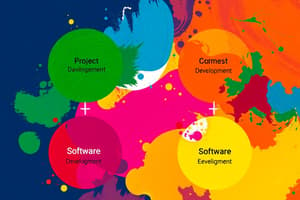Podcast
Questions and Answers
Which of the following is NOT typically considered a size factor influencing software engineering projects?
Which of the following is NOT typically considered a size factor influencing software engineering projects?
- Developer's favorite IDE (correct)
- Project complexity
- Team size
- Functionality
The Delphi Technique in software cost estimation relies primarily on automated tools to generate cost predictions.
The Delphi Technique in software cost estimation relies primarily on automated tools to generate cost predictions.
False (B)
Name three activities involved in planning a software project.
Name three activities involved in planning a software project.
Task breakdown, scheduling, risk management
The process of identifying user needs, functional and non-functional requirements is known as defining the ______.
The process of identifying user needs, functional and non-functional requirements is known as defining the ______.
Match the following software development models with their primary characteristic:
Match the following software development models with their primary characteristic:
In the context of software requirements, what is the primary purpose of a Data Flow Diagram (DFD)?
In the context of software requirements, what is the primary purpose of a Data Flow Diagram (DFD)?
What is the most significant limitation of the Basic COCOMO model? (Insanely difficult)
What is the most significant limitation of the Basic COCOMO model? (Insanely difficult)
Explain how the Product-Function Matrix (an extremely advanced concept) can be used to plan an organizational structure. (Insanely difficult)
Explain how the Product-Function Matrix (an extremely advanced concept) can be used to plan an organizational structure. (Insanely difficult)
Flashcards
Software Engineering
Software Engineering
A systematic approach to software development that encompasses various methods and processes.
Quality & Productivity Factors
Quality & Productivity Factors
Key parameters influencing software maintainability, efficiency, reliability, and usability.
Software Cost Estimation
Software Cost Estimation
The process of predicting the financial resources required for a software project.
COCOMO Model
COCOMO Model
Signup and view all the flashcards
Software Requirements Specification (SRS)
Software Requirements Specification (SRS)
Signup and view all the flashcards
Use Cases
Use Cases
Signup and view all the flashcards
Waterfall Model
Waterfall Model
Signup and view all the flashcards
Agile Methodology
Agile Methodology
Signup and view all the flashcards
Study Notes
Software Engineering Overview
- Software Engineering: A systematic approach to software development, considering various factors like project complexity, team size, and functionality.
- Quality & Productivity Factors: Crucial aspects include maintainability, efficiency, reliability, and usability.
- Managerial Issues: Effective project management involves planning, risk management, resource allocation, and scheduling.
Unit I: Introduction to Software Engineering
- Software Development Life Cycle (SDLC) Models: Key models like Waterfall, Agile, Spiral, and RAD are used to plan and structure a project.
- Project Planning: Involves defining the problem (user needs, functional/non-functional requirements), setting goals and requirements, choosing a solution strategy (SDLC model), and planning the development process (including organizational structure, task breakdown, scheduling, & risk management).
Unit II: Software Cost Estimation & Requirements
- Software Cost Estimation: Estimating costs involves considering factors like team skill, complexity, duration, and technology.
- Cost Estimation Techniques:
- COCOMO (Constructive Cost Model): Basic, intermediate, and advanced models used for estimations.
- Delphi Technique: Gathering expert opinions for estimations.
- Function Point Analysis (FPA): Technique for estimating software size based on functionality.
- Software Requirements: Defining system needs and documenting them formally in a Software Requirements Specification (SRS).
- Specification Techniques: Use cases, Data Flow Diagrams (DFDs), and Unified Modeling Language (UML) are used for documenting system requirements.
Important Software Engineering Concepts
- Software Engineering as a Layered Technology: The layered technology is a method of thinking about software engineering in terms of different layers, from the highest layer of software requirements specification all the way to the lowest level of code.
- Project Size Categories: Categorization of projects by size based on characteristics and constraints they face using factors like complexity & team size.
- Product-Function Matrix Organization: This is an organizational structure that focuses on the functional areas of a project or company.
- Prototype Life-Cycle Model: An approach for developing a working prototype of a system to refine its requirements before full development.
- Prototype Model vs. RAD Model: RAD models emphasize rapid development cycles, while prototypes focus on iterative refinement of requirements through early models before full development and implementation.
- Software Life Cycle Cost Model: A generic diagram depicting different phases in a software life cycle, showing how costs vary across various stages from beginning to end. This model helps in project planning.
Key Points in Project Planning
- Detailed Problem Definition: Precise identification of user needs, functional requirements, and non-functional needs, using examples.
- Development Process Planning: Selection of suitable SDLC models, organizational structure planning (team roles & responsibilities), task breakdown, scheduling, and risk management.
- Organizational Structure Planning: Defining reporting hierarchies for the development team in a planned manner.
Software Cost Estimation
- Significance of Software Cost Estimation: Estimating costs for a better understanding of budget required, resource planning and scheduling, and to track the progress against the defined budget.
- COCOMO Model Details: Comprehensive details about the COCOMO model for software cost estimation as per its phases.
Software Requirements
- Software Requirements Specification (SRS): A detailed and formal document outlining the functional and non-functional requirements for a software system.
- Data Flow Diagram (DFD): A graphical depiction of the flow of data within a system to understand the system components' interaction and data flow pathways.
- Structured System Analysis: Focuses on analyzing and understanding a system to clarify its specifications and create a detailed analysis.
- Formal Specification Techniques: Formal methods for specifying software system requirements using mathematical or logic-based techniques.
Studying That Suits You
Use AI to generate personalized quizzes and flashcards to suit your learning preferences.




